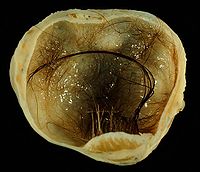
Repeated gamma knife radiosurgery enables longer tumor control in cases of highly-recurrent intracranial ependymoma
Sign Up to like & getrecommendations! Published in 2020 at "Journal of Neuro-Oncology"
DOI: 10.1007/s11060-020-03531-7
Abstract: Purpose Stereotactic radiosurgery (SRS) is a potential re-irradiation treatment for recurrent intracranial ependymoma after prior radiation therapy. The purpose of this study was to examine the efficacy and safety of repeated SRS in the treatment… read more here.
Keywords: intracranial ependymoma; srs; recurrent intracranial; tumor control ... See more keywords

Treatment and outcome of pediatric intracranial ependymoma after first relapse
Sign Up to like & getrecommendations! Published in 2022 at "Journal of Neuro-Oncology"
DOI: 10.1007/s11060-022-03975-z
Abstract: Almost 50% of children with intracranial ependymoma experience disease relapse, and their outcomes are extremely poor. The aim of this study was to investigate optimal salvage treatment for pediatric intracranial ependymoma after the first relapse… read more here.
Keywords: pediatric intracranial; intracranial ependymoma; first relapse; treatment ... See more keywords

RONC-08. SURVIVAL IMPACT OF POSTOPERATIVE RADIOTHERAPY TIMING IN PEDIATRIC AND YOUNG ADULT EPENDYMOMA
Sign Up to like & getrecommendations! Published in 2020 at "Neuro-Oncology"
DOI: 10.1093/neuonc/noaa222.780
Abstract: Abstract INTRODUCTION Postoperative radiotherapy is commonly given for WHO Grade 2–3 intracranial ependymoma. Clinicians generally aim to begin radiotherapy ≤5 weeks following surgery, but the optimal timing remains uncertain. METHODS The National Cancer Database was… read more here.
Keywords: intracranial ependymoma; postoperative radiotherapy; radiotherapy; radiotherapy timing ... See more keywords

The effect of adjuvant radiotherapy on overall survival in adults with intracranial ependymoma.
Sign Up to like & getrecommendations! Published in 2020 at "Neuro-oncology practice"
DOI: 10.1093/nop/npz070
Abstract: Background Adult intracranial ependymoma is rare, and the role for adjuvant radiotherapy (RT) is not well defined. Methods We used the National Cancer Database (NCDB) to select adults (age ≥ 22 years) with grade 2… read more here.
Keywords: overall survival; adjuvant radiotherapy; intracranial ependymoma; adults intracranial ... See more keywords

Role of Complex Networks for Integrating Medical Images and Radiomic Features of Intracranial Ependymoma Patients in Response to Proton Radiotherapy
Sign Up to like & getrecommendations! Published in 2019 at "Frontiers in Medicine"
DOI: 10.3389/fmed.2019.00333
Abstract: Human cancers exhibit phenotypic diversity that medical imaging can precisely and non-invasively detect. Multiple factors underlying innovations and progresses in the medical imaging field exert diagnostic and therapeutic impacts. The emerging field of radiomics has… read more here.
Keywords: medicine; intracranial ependymoma; medical images; complex networks ... See more keywords